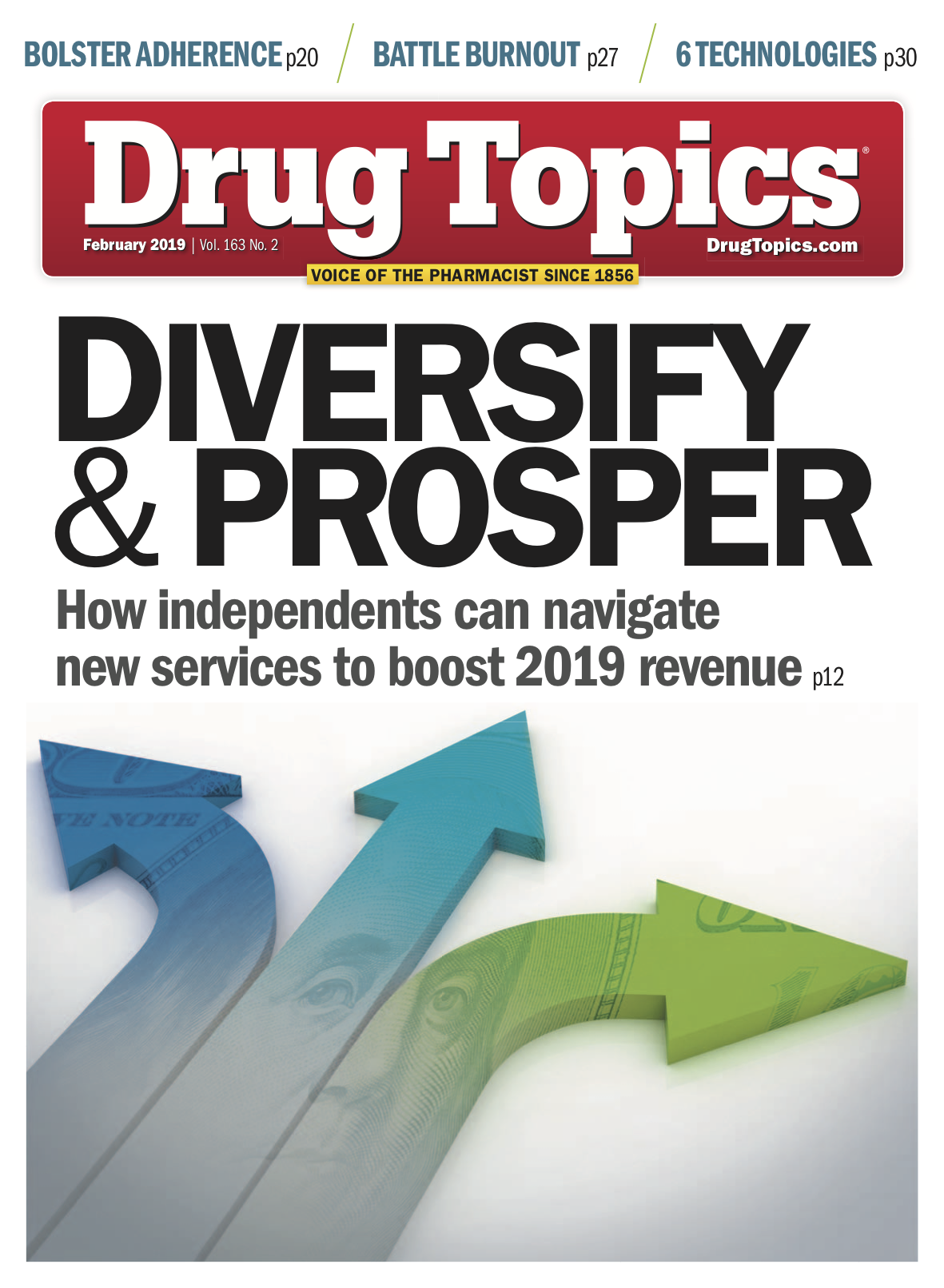Independent Pharmacies, Chains Enter Specialty Pharmacy
What needs to be considered before independent and chain pharmacies branch into the specialty arena.

If PBMs and payers can succeed in the specialty pharmacy arena, why shouldn’t independent and traditional pharmacies get into the act?
The top-four specialty pharmacies are all owned or co-owned by a PBM and account for about two-thirds of prescription revenues from pharmacy-dispensed specialty drugs, according to Drug Channels.
Forty-four percent of independent community pharmacies dispense specialty medications, with treatments for rheumatoid arthritis (87%), HIV (58%), and multiple sclerosis (46%) topping the list of disease states, according to the 2018 NCPA Digest. By 2021, 50% of drug spend is expected to be specialty drugs; however, these drugs make up only 2.5% of all drugs, according to IQVIA.
There is a good chance that chains and independent pharmacies will provide specialty medications if they have patients that regularly use their pharmacy and if they can acquire the drug from their wholesaler, says William Sullivan, principal consultant and general manager, Specialty Pharmacy Solutions LLC in Orlando.
“It is less likely when the specialty drugs are very expensive, and independents may not want to bear the cost of inventory, wait to get reimbursed, or lack the time and resources to navigate time-consuming efforts to obtain prior authorizations,” he says. “Therapeutic categories that don’t require significant patient monitoring, such as HIV, are more common with independents.”
Suzette DiMascio, president/CEO of CSI Specialty Group, a consulting firm in Sanford, Florida, says that if she were an independent pharmacy today, she would not venture into the specialty arena. PBMs are locking out small pharmacies to steer customers to their own specialty pharmacies, she says.
“They want to get their feet wet while the specialty pipeline is rich, but they don’t have the economies of scale that chains do,” she says. “Independents might start off winning the specialty war because of their close relationship with prescribers, but physicians are often forced to work with PBMs.”
The only way DiMascio feels independents have a chance to succeed is if they develop a contract with a health system or create a niche, such as medications for children’s diseases.
Continue reading on page 2...
A High-Touch Approach
Although independent community pharmacies are relatively new to specialty medications, John Becker, RPh, senior director of strategic initiatives, NCPA, believes they should be able to deliver these medications even if they are not full-fledged specialty pharmacies.
“If they are dispensing traditional drugs to their customers, they should be allowed to also deliver specialty-as long as they are accredited to do so,” he says.
Drug Channels reports that, in 2017, more than half of the 729 unique pharmacy locations that earned accreditation from two or three of the major accreditation organizations were independents.
DiMascio says that accreditation-a time-consuming process with many requirements-is no longer optional. Some PBMs are pressuring independent pharmacies to acquire accreditation within 18 months, making it almost prohibitive to get into the specialty business, she notes.
“Patients trust their independent community pharmacist with all of their healthcare needs, including specialty medications,” Becker says. “These medications often require additional counseling and other high-touch services due to their complex regimens, making the relationship with a community pharmacist all the more important.”
Gerry Crocker, CEO, the Association of Affiliated Pharmacies and Apothecaries (AAPA) in Detroit, a pharmacy buying group, agrees with Becker that patients like doing business with independents, where they can receive counseling about specialty and other drugs. “Mail order doesn’t generate the same adherence as going to a pharmacy, and when compliance of 90% or more is necessary for HIV drugs-the largest specialty seller-compliance is important,” he says.
The majority of specialty drugs are in the limited distribution drug category, where manufacturers decide which qualified specialty pharmacies gain access to their drugs. HIV and hepatitis C drugs are not limited and are available through general distribution channels because these patients are typically customers at a retail pharmacy already, Crocker says.
The downside is that HIV and hepatitis C drugs require clinical care services 24/7. With that additional overhead plus low reimbursement and high costs for these drugs, Crocker says he has witnessed pharmacies go under water on every script.
However, Sullivan says it is possible to be profitable, depending on the therapeutic class of drugs, acquisition costs, and payer mix that can dictate reimbursement.
Although he is seeing more independents jump into specialty pharmacy because they believe they can increase profitability, he says they have been losing business to big PBMs for specialty pharmacy for years.
Crocker also points out that some payers are reclassifying drugs and calling them “specialty,” which allows them to be more aggressive on reimbursement rates that are typically lower for specialty as a class.
Continue reading on page 3...
Chains and Specialty Pharmacy
“More and more chains are joining the specialty pharmacy space and need to know how to play in it and how to help patients,” says Chris Creamer, BSPharm, senior director of special pharmacy operations for Walgreens.
The chain has more than 300 community-based pharmacies dedicated to specialty medications, including access to limited distribution drugs, and complex high-touch patient care services with trained staff. Its pharmacists work with physicians to coordinate care and prior authorization when needed. Creamer estimates that Walgreens’ community pharmacies dispense 80 limited-distribution medications.
Even if specialty drugs are delivered by mail order, patients may receive consultation by phone or face to face. “There is connected service no matter where a consumer receives a drug. We emphasize expedited triage,” he says.
Walgreens tailors sites based on a preponderance of certain conditions in particular locations, Creamer says. For example, if a hospital oversees a number of transplants, trained pharmacists for transplant surgery will staff a nearby Walgreens pharmacy.
Kroger Prescription Plans offers a model that encompasses traditional retail in its grocery stores, specialty pharmacies, and what Richard Adams, senior vice president of Kroger Prescription Plans, describes as “a specialty-at retail-program.” These are Kroger community pharmacies that dispense traditional and some specialty drugs, but also provide nutritional, wellness, and community education services.
The majority of specialty drugs dispensed in the retail environment tend to be drugs that can be self-injected or taken orally, such as those for rheumatoid arthritis, HIV, transplants, and conditions requiring anticoagulant drugs. In many instances these conditions require special patient counseling because of their potential side effects, while the other classes do not need special storage or counseling. Asthma, migraine, and oncology drugs-if they can be self-administered-also can be dispensed in the retail environment.
Adams says the investment in specialty drugs can be “wildly” expensive, and can include building receiving facilities, special storage and handling, utilization management, efficient delivery, and a place to administer drugs, all of which require extra square footage. Pharmacies that dispense some specialty drugs also need to be accredited, licensed, and train pharmacists and staff, a big investment.
The Kroger model generates greater adherence and health outcomes because its community-based pharmacists can engage with customers and patients in positive ways, helping them optimize health outcomes through wellness, disease management, and medication therapy management services, he says.
Continue reading on page 4...
Is It Worth the Effort?
Becker admits there are challenges for independents venturing into the specialty drug market.
“It’s a daily battle for them to compete, but the easiest way is through physician referrals,” he says. “Competition is the name of the game. Pharmacies want to keep patients or else they may go elsewhere.” Entering the specialty marketplace also takes efficiency, prior authorization knowledge, and copayment reduction programs, he adds.
“Community pharmacists also require a steady stream of users to be profitable as they invest in specialty drugs from wholesalers to put on their shelves. Finally, reimbursement for specialty is often ratcheted down by PBMs,” Becker says.
Sullivan adds one more caveat: Pharmacies usually segregate specialty from retail operations to minimize operational disruptions and support a patient-centric service model that is not part of the retail model.
“If they want to get out of retail, they need to find new ways to do so,” Crocker says. “They are nipping at the heels of chain pharmacies from a pricing/access standpoint.” Purchasing groups like AAPA can help because they allow smaller pharmacies to buy drugs collectively through a prime vendor agreement.
Crocker acknowledges that the specialty drug marketplace might not be for the faint of heart, pointing out necessary investment in data reporting, buying and tracking inventory, high costs and low margins, call centers, accreditation, and inventory.
He ventures to say that in order to dispense a wide variety of specialty, it could cost as much as $500,000.
But, Crocker says independents can compete if they develop relationships with specialty prescribers; provide services to providers, such as assistance with prior authorization; and partner with payers for inclusion in their specialty networks.
